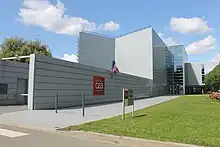CEA Paris-Saclay
The CEA Paris-Saclay (formerly CEA Saclay) center is one of nine centers belonging to the French Alternative Energies and Atomic Energy Commission (CEA). The Saclay site hosts the administrative headquarters of the CEA. Historically, it was the heart of French nuclear research since Frederic Joliot-Curie founded it in 1946.[1][2] Its campus was designed by the architect Auguste Perret.[3]
CEA Paris-Saclay | |
 East entrance of CEA Paris-Saclay | |
| Formation | March 1, 1946[1] |
|---|---|
| Coordinates | 48.72470°N 2.14876°E |
Key people | Christian Bailly, director |
| Website | www-centre-saclay |
It is now a part of Paris-Saclay University, along with other organizations including CentraleSupélec, CNRS, ENS Paris-Saclay, HEC Paris, and the IHES.
History
The CEA was launched in 1945, with the first site being in Fontenay-aux-Roses. In 1952 the Saclay site was realized.[4]
Organization
Since February 2017, various sites were grouped together to CEA Paris-Saclay, including[5][6]
- Saclay site
- Fontenay-aux-Roses site
- Paris site
- Évry site
- Orsay site
Research
The complex employs more than 7,000 scientists (including other smaller Île-de-France sites) and is located in the Essonne department of northern France, south of Paris on the Saclay Plateau.[7]
The research carried out ranges from fundamental research to applied research and, thanks to the Orpheus research reactor, lasers and magnetic resonance research into the State of Matter.
Research at Saclay is focussed on different topics:
- Applied nuclear research: Research is carried out to optimise current and future French nuclear reactors using the Osiris experimental reactor and the Tamaris earthquake simulation laboratory as well as further research into nuclear waste management.
- Technology research: Research into IT systems used in nuclear installations, man-machine interface as well as sensor technology.
- Health research: Research into the effects of radioactivity on living cells and molecules, protein engineering and Medical imaging.
- Environmental research: Research into the effects of climate change and greenhouse gases.
- Fundamental Research.
Notable subsidiaries
- Institut national des sciences et techniques nucléaires (National Institute for Nuclear Science and Technology) or INSTN which is dedicated to the academic and professional training in the field of atomic energy.
- Institut Rayonnement et Matière de Saclay (Saclay Institute of Matter and Radiation) or IRAMIS, houses the Lasers, Interactions and Dynamics Laboratory (LIDyL) research unit. Anne L'Huillier and Pierre Agostini both attained breakthroughs in attosecond lasers at LIDyL which led to their prize share of the 2023 Nobel prize in physics, along with Ferenc Krausz.
- NeuroSpin is a neuroimaging research center with some of the most powerful MRI machines in the world
People
- Jules Gueron, first director of the CEA's nuclear research center
- Jean-Baptiste Waldner, alumnus
- Étienne Klein, physicist, philosopher of science, author, and radio host
- Anne L'Huillier, ultra-fast laser physics, 2023 Nobel laureate in physics
- Pierre Agostini, pioneer of strong-field laser physics, 2023 Nobel laureate in physics
References
- "Du génie nucléaire au génie biologique" (in French). Retrieved 3 October 2023.
- Rayner-Canham, Marelene F. (1997). A Devotion to Their Science: Pioneer Women of Radioactivity. Philadelphia, Pa.: Chemical Heritage Foundation. pp. 97–123. ISBN 978-0-7735-6658-3. OCLC 191818978.
- "CEA de Saclay: le palais de la science d'Auguste Perret" (in French). Retrieved 28 October 2022.
- "Histoire du site CEA de Saclay : Le plus grand centre de recherche en Europe". 2022-11-25. Retrieved 2023-10-08.
- fontenay-aux-roses
.cea .fr /far /Pages /Le-centre /histoire .aspx - www
.cea .fr /paris-saclay /Pages /informations-pratiques /plan-acces .aspx - "CEA Paris-Saclay" (in French). Retrieved 1 December 2022.
- https://www.linkedin.com/in/christian-bailly
- https://www.cea.fr/presse/Pages/actualites-communiques/institutionnel/michel-bedoucha-nouveau-directeur-du-centre-cea-de-saclay.aspx
- https://www.linkedin.com/in/michel-bedoucha-b0645511a